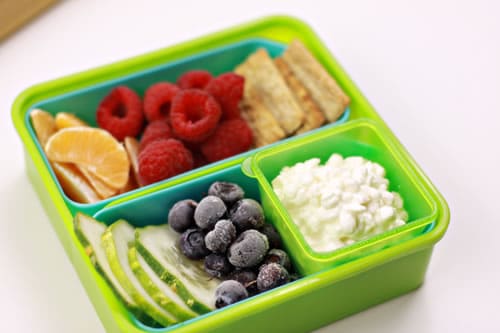Defining “Unprocessed”
Sep 28, 2010, Updated Sep 12, 2020

With just a few days to go before we start our month of no processed foods whatsoever, I’ve been getting a lot of questions about the definition of “unprocessed” — and whether specific foods are or are not okay during this challenge.
Before I go any further, let me reiterate that you need to do what’s right for you. No one is watching over your shoulder, and just as all food is intensely personal, so too is this challenge.
Likewise, if you feel you need to make any exceptions, by all means feel free to do so. Just make sure it’s a deliberate choice whenever possible.
My definition may not match your definition — and that’s okay. In fact, I encourage disagreement and discussion, since that’s the best way for us to learn together.
I also recognize that my definition isn’t perfect. My goal here isn’t “perfection” — it’s more to help spark a dialogue, increasing awareness about how our food is made, what we’re putting into our bodies, and how we relate to our food. (I’m also hoping to shed that last bit of pudge and finally get my six-pack abs, but that’s another story.)
Having said all that, here’s my working definition of unprocessed. I call it The Kitchen Test:
Unprocessed food is any food that could be made by a person with reasonable skill in a home kitchen with readily available, whole-food ingredients.
It doesn’t mean that you have to be able to make the food — but that the food could be made in a home kitchen by someone who knows what they’re doing. If it needs high-powered, industrial equipment, or could only be made in a laboratory, then it’s out.
Here’s a good example. Look at the ingredients for a PowerBar Triple Threat® Chocolate Peanut Butter Crisp:
CORN SYRUP, SOY CRISPS (SOY PROTEIN ISOLATE, RICE FLOUR, ALKALIZED COCOA), CHOCOLATEY COATING (SUGAR, FRACTIONATED PALM KERNEL OIL, COCOA, WHEY, NONFAT MILK, SOY LECITHIN, NATURAL VANILLA FLAVOR), WHOLE OATS, DRY ROASTED PEANUTS, SOY PROTEIN ISOLATE, INULIN (FROM CHICORY), NATURAL FLAVORS (CONTAINS PEANUT, MILK, SOY LECITHIN), RICE CRISPS (MILLED RICE, SUGAR, SALT, BARLEY MALT), SALTED PEANUT BUTTER, VEGETABLE GLYCERIN, AND LESS THAN 2% OF PEANUT FLOUR, ALMOND BUTTER, SALT, SOY LECITHIN, MINERALS: CALCIUM PHOSPHATE, POTASSIUM PHOSPHATE, FERROUS FUMARATE (IRON), VITAMINS: ASCORBIC ACID (VITAMIN C), VITAMIN B6 HYDROCHLORIDE, RIBOFLAVIN (VITAMIN B2), THIAMINE MONONITRATE (VITAMIN B1).
I’ve bolded any ingredients that I’m pretty sure you can’t make at home (or without some sort of industrial process). Compare that to the ingredients of a Cashew Cookie Lara Bar:
CASHEWS, DATES.
I’m absolutely certain that a cook with average skills could make something comparable to the Lara bar in your kitchen. But the PowerBar? Not so much.
Okay, so let me toss out a few other specific foods that I’ve been asked about:
Chocolate. Yup, it’s okay, because it’s possible to make chocolate at home. However, if the store-bought chocolate contains extra emulsifiers, flavorings, or other additives that you wouldn’t use if you were make it at home, it’s off the list.
Coffee. Yup. Try this fun project: Buy some green coffee beans (they’ve already been cleaned for you), and toast them in your popcorn air popper. (Skip the little yellow, blue, or pink packets and the powdered creamer.) Or you could grow your own coffee plant, and then wet-process the beans yourself. Totally doable at home (how much time do you have?)
Beer. Yup, I’ve got quite a few friends who make beer at home (one even grows his own hops — he makes truly incredible beers. Just saying.)
Wine. Yes, I’ve got quite a few friends who make wine at home. There is the question of sulfites, though. My winemaker friends usually add sulfites (sourced from winemaking suppliers, not from your regular grocery story, I believe) — so you’ll need to decide for yourself if you’ll seek out sulfite-free wines.
[Wine Update: Please read Dave’s clarification in the comments.]
Vodka, Gin, and other Spirits. Although I don’t recommend distilling your own (and it may be illegal), it’s certainly possible to do this at home. Just skip the gimmicky flavored ones and I’m sure you’ll be fine. Of course, it depends on how picky you want to be. You may wish to consider what sugars/starches are being used to feed the fermentation process. If you want to research this some more, please report back!
Bacon and Sausage. As long as there are no additives (nitrates, flavorings, etc.), and it’s a high-quality product, you’re probably okay here. Maybe this is a good opportunity to get to know a local butcher.
“Veggie Burgers “and “Fake Meats.” Most of these should be avoided, as they usually contain a lot of textured vegetable protein (which I’m almost certain you couldn’t make at home). But if you are in a pinch, you can probably find something that’ll work. You’ll really need to read the ingredient list: An All-American Flame-Grilled Boca Burger is definitely out. Dr. Praeger’s Gluten Free California Veggie Burger is certainly better, though it’s got a couple of ingredients that are questionable. (Personally, I’m going to do my best to avoid these).
Cooking Oils. It is possible to press your own oils at home, though it would be a rather inefficient process. I would expect that nut oils would be easier (just grind them up and let them separate, like your jar of peanut butter, right?). Also, these old oil press instructions and drawings are fun.
Salt. Depending on how refined it is, this may or may not be okay. Stick with the natural, unprocessed salts such as the fabulous Fleur De Sel.
Sugar. Usually, the term “sugar” refers to bleached table sugar, those fine-white granulated crystals that come from sugar cane or sugar beets. The bleaching is done with sulfur dioxide, an ingredient that hopefully isn’t in your pantry. Next!
Turbinado Sugar (“Raw” Sugar) is the same stuff — but it hasn’t been bleached. I think it would be possible to make turbinado sugar crystals at home, if you had some sugar cane stalks ready to go. Although there are a couple of steps in the commercial process that you couldn’t do, I’m guessing you could still get the crystals if you’re patient enough (perhaps a countertop food dehydrator would help evaporation).
[Sugar Update: Please read MrJackHonky’s thoughts on sugar in the comments.]
Honey. Good to go; in fact, this is probably the most “unprocessed” sweetener available.
Agave Nectar. You’re probably okay with this one. Some agave is simply heated (at relatively low temperatures). It may also be enzymatically processed. Any agave experts out there want to weigh in?
Corn Syrup and High Fructose Corn Syrup. Both of these are too complicated to make at home. Off the list.
Flour. As long as it’s 100% whole grain flour, it’s okay. You could certainly grind whole grains in your kitchen. As Bob’s Red Mill says, one pound in, one pound out. Refined flours, however, have had the germ and bran removed (leaving just the fluffy endosperm) — and are likely bleached or brominated, and may be enriched with nutrients that had been previously removed.
[Flour Update: Refined flour, as long as it’s un-bleached and un-enriched, actually would pass the Kitchen Test. Check out this flour followup in the forums.]
Corn Meal and Masa. Again, if these are made with the whole grain, then it’s all good.
Butter. Yup, you could certainly make real butter at home, if you’re so inclined.
Cheese. Yup. In fact, I already make cheese at home. Skip the “pasteurized processed” cheeses, or “cheese foods,” of course.
Nut Butters. Look at the ingredient list. If it’s just “Nuts & Salt” (or better yet, just Nuts), then it’s great. But if it’s got stabilizers, sweeteners, and oils, it’s a no-no (Skippy, I’m looking at you!)
Spices. Yup, these are okay. You could certainly grow them at home, dry them, and then grind them as needed.
Breads. Again, it’s all about the ingredient list. The best option, of course, is to make it at home. But if it’s store-bought, read the ingredient list. The flour should be whole grain (avoid these pitfalls), and there shouldn’t be fillers, preservatives, artificial sweeteners (yes, they sometimes add those to 100% whole wheat breads. Oroweat, I’m looking at you and your acesulfame potassium!)
Okay, I think that covers most of the biggies. I’m sure I’ve missed some, so please ask in the comments. Also, if you disagree with any of my conclusions, or can add any other bits of advice, we’d all love to hear about it!
—
If you haven’t taken the October: Unprocessed pledge yet, now’s the time!
Image from homedistiller.org.




















Sounds simple for one who is home most of the time; I travel and eat 4-6 meals at home per week. Suggestions?
This is a very loose guide/list, yet a real eye-opener for me. If it would, in any way, be difficult for average folks to follow these guidelines, then we are in a much more sorry state than I ever imagined. Unprocessed to me means what it means; let x = x. Of course, peeling a banana, technically, is processing, but in the spirit of the meaning it’s a far, far, far cry from harvesting, milling, and recipe-ifying wheat. Either way, it’s a start, I guess.
Like the project. Although I clearly missed the month of October, I am trying to get to the point where my list of truly processed foods is under 10 all the time. Couple of things that may infuriate the non-meat eaters and meat eaters alike. First of all Nitrates are naturally occurring in vegetables especially celery. When you see bacon that says “Nitrate free” it is a misnomer because they are usually using some kind of concentrated celery juice to cure that bacon. In fact I have used a whole ground up head of celery along with salt in a brine to cure a corned beef in the fridge just to prove the point, so I think you should update your bias against nitrates because a person can create them easily at home. Oils: I will continue to buy and use coconut oil because although I probably couldn’t do it… Read more »
Interesting list, hence a little bit biased. If you consider the average person to be able to extract sugar from cane at home, then you should also include corn syrup and high fructose corn syrup.
Cheese – yes, it is possible to make cheese at home, but is the average person able to make for example parmesan and gorgonzola? Should they be excluded?
Gelatin – yes or no? I doubt, that anybody can make that at home….
Also, in some old cookbooks from the 60s salicylic acid is frequently used as a preservative. Nowadays it is not even allowed to be used in commercial products anymore (at least in Europe, not sure about the US). Most preservatives are readily available and could be easily added to your meals. I’m wondering, if they should be included.